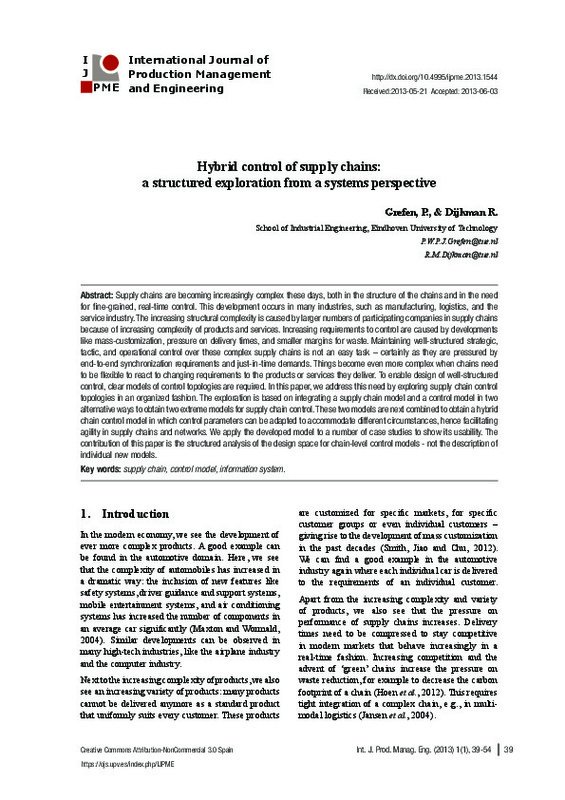Alonso, G., Casati, F., Kuno, H., & Machiraju, V. (2004). Web Services. doi:10.1007/978-3-662-10876-5
Beer, S. (1984). The Viable System Model: Its Provenance, Development, Methodology and Pathology. Journal of the Operational Research Society, 35(1), 7-25. doi:10.1057/jors.1984.2
Camarinha-Matos, L. M., Boucher, X., & Afsarmanesh, H. (Eds.). (2010). Collaborative Networks for a Sustainable World. IFIP Advances in Information and Communication Technology. doi:10.1007/978-3-642-15961-9
[+]
Alonso, G., Casati, F., Kuno, H., & Machiraju, V. (2004). Web Services. doi:10.1007/978-3-662-10876-5
Beer, S. (1984). The Viable System Model: Its Provenance, Development, Methodology and Pathology. Journal of the Operational Research Society, 35(1), 7-25. doi:10.1057/jors.1984.2
Camarinha-Matos, L. M., Boucher, X., & Afsarmanesh, H. (Eds.). (2010). Collaborative Networks for a Sustainable World. IFIP Advances in Information and Communication Technology. doi:10.1007/978-3-642-15961-9
Von Corswant, F., & Fredriksson, P. (2002). Sourcing trends in the car industry. International Journal of Operations & Production Management, 22(7), 741-758. doi:10.1108/01443570210433526
Grefen, P., Ludwig, H., & Angelov, S. (2003). A Three-Level Framework for Process and Data Management of Complex E-Services. International Journal of Cooperative Information Systems, 12(04), 487-531. doi:10.1142/s0218843003000838
Grefen, P., Ludwig, H., Dan, A., & Angelov, S. (2006). An analysis of web services support for dynamic business process outsourcing. Information and Software Technology, 48(11), 1115-1134. doi:10.1016/j.infsof.2006.03.010
Grefen, P., Mehandjiev, N., Kouvas, G., Weichhart, G., & Eshuis, R. (2009). Dynamic business network process management in instant virtual enterprises. Computers in Industry, 60(2), 86-103. doi:10.1016/j.compind.2008.06.006
Grefen, P. (2010). Mastering E-Business: Routledge.
Gunasekaran, A., & Ngai, E. W. . (2004). Information systems in supply chain integration and management. European Journal of Operational Research, 159(2), 269-295. doi:10.1016/j.ejor.2003.08.016
Hoen, K., Tan, T., Fransoo, J., van Houtum, J. (2012). Effect of Carbon Emission Regulations on Transport Mode Selection under Stochastic Demand. Flexible Services and Manufacturing Journal Jansen, B., Swinkels, P., Teeuwen, G., van Antwerpen de Fluiter, B., Fleuren, H. (2004). Operational Planning of a Large-Scale Multi-Modal Transportation System. European Journal of Operational Research 156(1):41-53.
Luftenegger, E., Grefen, P., Weisleder, C. (2012). The Service Dominant Strategy Canvas: Towards Networked Business Models. Proceedings 13th IFIP Working Conference on Virtual Enterprises: 207-215.
Lusch, R. F., Vargo, S. L., & O’Brien, M. (2007). Competing through service: Insights from service-dominant logic. Journal of Retailing, 83(1), 5-18. doi:10.1016/j.jretai.2006.10.002
Maxton, G. P., & Wormald, J. (2004). Time for a Model Change. doi:10.1017/cbo9780511488535
Mehandjiev, N., & Grefen, P. (Eds.). (2010). Dynamic Business Process Formation for Instant Virtual Enterprises. Advanced Information and Knowledge Processing. doi:10.1007/978-1-84882-691-5
Muckstadt, J. A., Murray, D. H., Rappold, J. A., & Collins, D. E. (2001). Information Systems Frontiers, 3(4), 427-453. doi:10.1023/a:1012824820895
Olhager, J. (2012). The Role of Decoupling Points in Value Chain Management. In: Jodlbauer, H., Olhager, J., Schonberger, R. (2012). Modelling Value: Springer.
Porter, M. (1985). Competitive Advantage: Creating and Sustaining Superior Performance: Free Press.
Sarkis, J., & Talluri, S. (2004). Evaluating and selecting e-commerce software and communication systems for a supply chain. European Journal of Operational Research, 159(2), 318-329. doi:10.1016/j.ejor.2003.08.018
Schulte, S., Schuller, D., Steinmetz, R., & Abels, S. (2012). Plug-and-Play Virtual Factories. IEEE Internet Computing, 16(5), 78-82. doi:10.1109/mic.2012.114
Upton, D., McAfee, A. (1996). The Real Virtual Factory. Harvard Business Review 74(4):123-133.
Verdouw, C. N., Beulens, A. J. M., Trienekens, J. H., & van der Vorst, J. G. A. J. (2010). A framework for modelling business processes in demand-driven supply chains. Production Planning & Control, 22(4), 365-388. doi:10.1080/09537287.2010.486384
[-]








